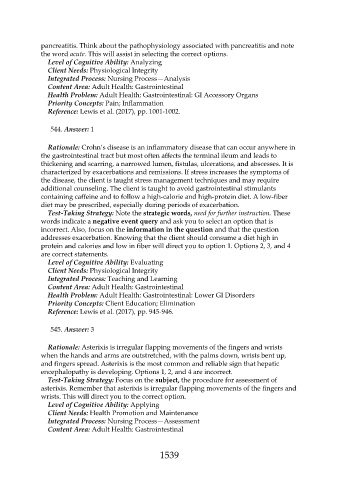Page 1539 - Saunders Comprehensive Review For NCLEX-RN
P. 1539
pancreatitis. Think about the pathophysiology associated with pancreatitis and note
the word acute. This will assist in selecting the correct options.
Level of Cognitive Ability: Analyzing
Client Needs: Physiological Integrity
Integrated Process: Nursing Process—Analysis
Content Area: Adult Health: Gastrointestinal
Health Problem: Adult Health: Gastrointestinal: GI Accessory Organs
Priority Concepts: Pain; Inflammation
Reference: Lewis et al. (2017), pp. 1001-1002.
544. Answer: 1
Rationale: Crohn’s disease is an inflammatory disease that can occur anywhere in
the gastrointestinal tract but most often affects the terminal ileum and leads to
thickening and scarring, a narrowed lumen, fistulas, ulcerations, and abscesses. It is
characterized by exacerbations and remissions. If stress increases the symptoms of
the disease, the client is taught stress management techniques and may require
additional counseling. The client is taught to avoid gastrointestinal stimulants
containing caffeine and to follow a high-calorie and high-protein diet. A low-fiber
diet may be prescribed, especially during periods of exacerbation.
Test-Taking Strategy: Note the strategic words, need for further instruction. These
words indicate a negative event query and ask you to select an option that is
incorrect. Also, focus on the information in the question and that the question
addresses exacerbation. Knowing that the client should consume a diet high in
protein and calories and low in fiber will direct you to option 1. Options 2, 3, and 4
are correct statements.
Level of Cognitive Ability: Evaluating
Client Needs: Physiological Integrity
Integrated Process: Teaching and Learning
Content Area: Adult Health: Gastrointestinal
Health Problem: Adult Health: Gastrointestinal: Lower GI Disorders
Priority Concepts: Client Education; Elimination
Reference: Lewis et al. (2017), pp. 945-946.
545. Answer: 3
Rationale: Asterixis is irregular flapping movements of the fingers and wrists
when the hands and arms are outstretched, with the palms down, wrists bent up,
and fingers spread. Asterixis is the most common and reliable sign that hepatic
encephalopathy is developing. Options 1, 2, and 4 are incorrect.
Test-Taking Strategy: Focus on the subject, the procedure for assessment of
asterixis. Remember that asterixis is irregular flapping movements of the fingers and
wrists. This will direct you to the correct option.
Level of Cognitive Ability: Applying
Client Needs: Health Promotion and Maintenance
Integrated Process: Nursing Process—Assessment
Content Area: Adult Health: Gastrointestinal
1539

